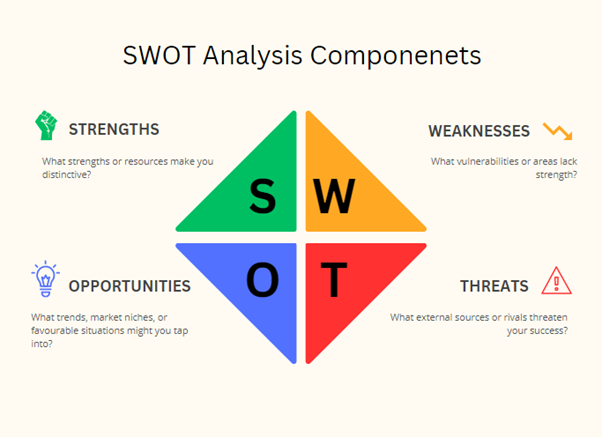
This is the world of the business era, where making the right decisions is important for success. Whether you are starting a business, running a well-established organization, or planning individual development, knowing your strengths and weaknesses from within, coupled with opportunities and threats from the outside, could be a winner. That's where SWOT analysis fits the bill, a straightforward yet efficacious tool which enables individuals and organizations to face their strategic situation with confidence.
In this blog, we'll go deep into what a SWOT analysis is, examine real-world examples, and dissect how to make one step by step. By the end, you'll not only know the SWOT analysis meaning but also feel confident to use this strategy in your case.
SWOT acts as an analytical method for identifying internal organizational strengths and weaknesses, along with external possibilities and threats that shape personable and organizational directions. It presents a systematic process to analyze internal and external aspects influencing success and assists in constructing a balanced approach.
This structure can be applied extensively across sectors, from product planning and marketing to individual career mapping. Whether you’re a student looking for cheap assignment help UK or a business aiming for growth, this tool promotes honest consideration and helps identify possible avenues for development and strengthening.

Conducting a SWOT analysis has many advantages:
It allows you to visualize the larger picture and allocate efforts accordingly.
You can match your capabilities and resources with market possibilities.
The threat analysis technique enables you to detect threats which form the basis for developing reduction strategies to lower security risks.
Periodic SWOT analysis can monitor progress and evolve strategies in the long run.
A SWOT analysis serves as a useful instrument for both business owners and individuals to support their decision-making activities. The knowledge of your personal strengths and weaknesses can also help you format an assignment more effectively, which delivers structured and clear presentation of ideas.
The SWOT analysis format is simple and usually shown as a 2x2 matrix. Such an arrangement simplifies the structure of your results and helps visualize how various factors interact with one another.
| Strengths | Weaknesses |
| Distinctive selling points | Inadequate resources |
| Excellent brand reputation | Skill deficiencies |
| Sticking customers | Excessive production cost |
| Opportunities | Threats |
| Trends in emerging markets | Competitive pressure |
| New technology | Economic downturns |
| Untapped audience | Changing regulations |
With this table, you can easily sort insights and begin to brainstorm strategic steps.
Creating a SWOT analysis doesn’t have to be complicated. Follow these steps to conduct a thorough assessment:
Your first step should begin with defining your target objective. Your target topic for analysis exists within business operations or projects or you want to evaluate your career development. Your analysis will benefit from having a defined objective to organize your analysis process.
The implementation involves either starting new product releases or working on personal brand advancement.
If you’re conducting this analysis for a business or project, involving key stakeholders ensures diverse perspectives.
Take time to list and identify factors in each quadrant. Be objective and honest the more realistic your evaluation, the more valuable your analysis will be.
All factors are not equal. Prioritize those that have the greatest influence on your goals or strategy.
Employ your results to develop strategies that:
Repetitive SWOT analysis serves as a continuous method. Regular revisions of your strategy must be done based on shifting conditions.
Through this method, your SWOT analysis is a living document that drives actual action instead of merely an evaluation.
Let's consider an SWOT analysis example to observe how it actually works. Suppose a small, environmental skincare company wants to extend its market influence:
| Strengths | Weaknesses |
| Sustainable ingredients | ow marketing budget |
| Dedicated niche base | Restricted distribution |
| High social media presence | Narrow product line |
| Opportunities | Threats |
| Growing demand for clean beauty | Existing competitors |
| Collaborations with influencers | Disruptions in supply chain |
| E-commerce expansion | Shift in consumer behavior |
This example illustrates how SWOT insights translate into practical strategies for growth and resilience.
Understanding your SWOT factors lays only the foundation because the actual value comes from using this knowledge to develop practical strategic approaches. An illustration of SWOT strategic planning for a technology startup shows the following:
Hire a skilled development team to build a unique app that addresses an emerging market demand.
Leverage a strong brand name to differentiate and compete with others.
Spend on employee training to bridge skill gaps and catch new technological waves.
Reduce discretionary expenses to develop financial buffers against market declines.
By actively integrating insights from quadrants, you can construct balanced strategies that optimize potential while reducing risk.
Besides the simplicity of SWOT analysis, several common errors can reduce its value:
By being aware of these errors, you can keep your SWOT analysis a useful, dynamic tool.
A SWOT analysis serves as more than organizing plans because it drives inner understanding clear strategies and active business development. SWOT serves as a powerful framework which delivers crucial insights that drive better choices for business leaders together with individuals who develop their paths.
Through a SWOT analysis studying practical examples and developing strategy skills, you will achieve an effective transformation of potential into achievements. Start creating your strength and weakness map alongside studying opportunities and threats. You should use team members to assess your strengths and weaknesses or evaluate external circumstances to see your vision become real.
The 3 C's refer to customers, competitors, and Company. SWOT analysis functions through three main categories, which enable both internal and external assessment.
Here are five common types:
SWOT analysis identifies internal aspects through assessment of company strengths and weaknesses which constitute elements within organizational control.
External factors:Opportunities and Threats(outside influences, like market trends or competitors).
A SWOT analysis defines both the methodology and particular illustrations.SWOT analysis stands as a strategic approach to uncover both organization inner capabilities and external opportunities together with threats and internal limitations.
Standard SWOT analysis contains 4 elements so the addition of a fifth category enables Prioritization or Action Plans to develop strategies from analysis findings.
The SWOT analysis demands strategic actions as the follow-up steps to perform following the analytical phase.